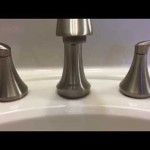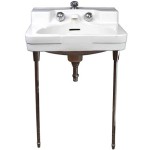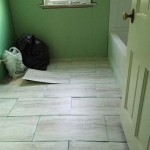How Do You Clean Bathroom Sink Drain?
A clogged bathroom sink drain is a common household problem. Hair, soap scum, toothpaste, and other debris accumulate over time, restricting water flow and potentially leading to unpleasant odors. Regularly cleaning the bathroom sink drain is essential for maintaining hygiene, preventing costly plumbing repairs, and ensuring optimal functionality. Several methods exist for cleaning a bathroom sink drain, ranging from simple home remedies to more involved mechanical techniques. Choosing the appropriate method depends on the severity of the clog, the materials available, and the user's comfort level. This article provides a comprehensive guide to various methods for effectively cleaning a bathroom sink drain.
Preventative Measures and Regular Maintenance
Before delving into specific cleaning methods, it is important to acknowledge the significance of preventative measures. Implementing practices that minimize the accumulation of debris within the drain system can significantly reduce the frequency with which serious clogs occur. The integration of a drain strainer or screen over the drain opening is a simple yet highly effective method. These devices capture hair, soap particles, and other solid materials before they enter the drainpipe, preventing them from accumulating and forming stubborn blockages. Regularly clearing the strainer of collected debris is a crucial step in maintaining its effectiveness.
Flushing the drain with hot water after each use can also contribute to preventative maintenance. Hot water helps to dissolve soap scum and prevent the build-up of grease and oily substances that can contribute to clogs. Allowing the hot water to run for several minutes ensures that a sufficient amount of water passes through the drainpipe, effectively flushing away loose debris and minimizing the risk of accumulation.
Finally, avoid pouring grease, oil, or food scraps down the drain. These substances solidify as they cool and can adhere to the inner walls of the drainpipe, creating a sticky residue that attracts other debris and exacerbates the formation of clogs. Instead, dispose of these materials in the trash or compost bin.
Simple Cleaning Solutions: Hot Water, Baking Soda, and Vinegar
For minor clogs or preventative maintenance, simple household solutions can often be effective. Hot water, baking soda, and vinegar are readily available and environmentally friendly alternatives to harsh chemical drain cleaners. The effectiveness of these methods lies in their ability to dissolve organic matter and dislodge minor blockages.
Hot Water Flush: As mentioned earlier, a simple flush with hot water can often clear minor clogs or prevent the build-up of debris. After removing any standing water from the sink, carefully pour a kettle or pot of boiling water down the drain. Exercise caution when handling boiling water to avoid burns. Repeat the process several times, if necessary, to see if the clog clears.
Baking Soda and Vinegar: This combination creates a chemical reaction that can help to break down clogs. Start by pouring about one cup of baking soda down the drain. Follow this with one cup of white vinegar. The mixture will fizz and bubble; this is the chemical reaction at work. Allow the mixture to sit for at least 30 minutes, or preferably overnight, to allow the baking soda and vinegar to effectively break down the clog. After the waiting period, flush the drain with hot water to remove the dissolved debris.
Baking Soda and Salt: An alternative to the baking soda and vinegar method is to use baking soda and salt. Combine equal parts baking soda and salt (about one cup of each) and pour the mixture down the drain. Follow this with boiling water. The salt acts as an abrasive agent, helping to scrub the inner walls of the drainpipe and dislodge any stubborn debris. Allow the mixture to sit for at least 30 minutes before flushing with hot water.
Mechanical Methods: Plungers and Drain Snakes
When simple cleaning solutions fail to clear a clog, mechanical methods may be necessary. Plungers and drain snakes are effective tools for dislodging blockages and physically removing debris from the drainpipe.
Using a Plunger: A plunger creates suction that can dislodge clogs by forcing water back and forth through the drainpipe. Ensure that there is enough water in the sink to cover the cup of the plunger. Create a tight seal around the drain opening with the plunger cup. Use a firm, up-and-down motion to plunge the drain for several minutes. Remove the plunger to check if the water drains freely. Repeat the process several times, if necessary, until the clog is cleared. For sinks with overflow drains, it is essential to block the overflow opening with a wet cloth or tape to ensure that the plunger creates sufficient suction.
Using a Drain Snake: A drain snake, also known as a plumbing snake or auger, is a flexible tool that can be inserted into the drainpipe to break up or retrieve obstructions. There are various types of drain snakes available, ranging from inexpensive plastic models to more durable metal versions. Slowly insert the drain snake into the drain opening, feeding it down the drainpipe until you encounter resistance. Once you reach the clog, rotate the snake to break up the obstruction or hook onto the debris. Carefully pull the snake back out of the drainpipe, removing any debris that is attached. Repeat the process several times, if necessary, until the clog is cleared. After using a drain snake, thoroughly clean it with soap and water to remove any residue.
For more complex plumbing systems, a motorized drain auger might be required. This tool is commonly used by professional plumbers and offers a stronger solution to tough clogs.
Disassembling the Drainpipe: Cleaning the P-Trap
If simple solutions and mechanical methods fail to clear the clog, it may be necessary to disassemble the drainpipe and manually clean the P-trap. The P-trap is a curved section of pipe located under the sink that traps debris and prevents sewer gases from entering the home. This section is often the primary location of clogs.
Before disassembling the drainpipe, place a bucket or container under the P-trap to catch any water or debris that may spill out. Loosen the slip nuts that connect the P-trap to the drainpipe using pliers or a wrench. Carefully remove the P-trap and empty its contents into the bucket. Inspect the P-trap for any accumulated debris, such as hair, soap scum, or other solid materials. Use a wire brush or small tool to remove any stubborn debris from the inside of the P-trap.
Thoroughly rinse the P-trap with water to remove any remaining residue. Inspect the other sections of the drainpipe for any signs of clogs or blockages. If necessary, use a drain snake or other tool to clear any obstructions. Once all components are clean, reassemble the drainpipe by tightening the slip nuts. Ensure that the connections are secure to prevent leaks. After reassembling the drainpipe, run water down the drain to check for leaks and to ensure that the clog has been cleared.
When reassembling the P-trap, always check the condition of the rubber washers present between the slip nuts and pipes. Replace deteriorated or damaged washers with new ones to ensure a tight, leak-proof seal. Thread seal tape can also be used to wrap the threads of the pipe connections to further enhance the seal and prevent leaks. Over-tightening the slip nuts can potentially damage the pipes, so proceed with caution and tighten them just enough to create a secure connection.

3 Ways To Clean A Bathroom Sink Drain Wikihow

5 Natural Ways To Unclog A Bathroom Sink Hiller How

How To Unclog A Sink The Right Way

Best Ways To Clean Your Bathroom Sink Drain Yourself

3 Ways To Clean A Bathroom Sink Drain Wikihow

How To Clean A Stinky Sink Drain By Home Repair Tutor

How Often Should I Clean My Drains At Home

How To Clean Bathroom Drains Unclog Your Shower And Sink

3 Ways To Clean A Bathroom Sink Drain Wikihow

5 Homemade Drain Cleaners That Are Safe For Your Plumbing System Gold Star Heating Cooling
Related Posts







